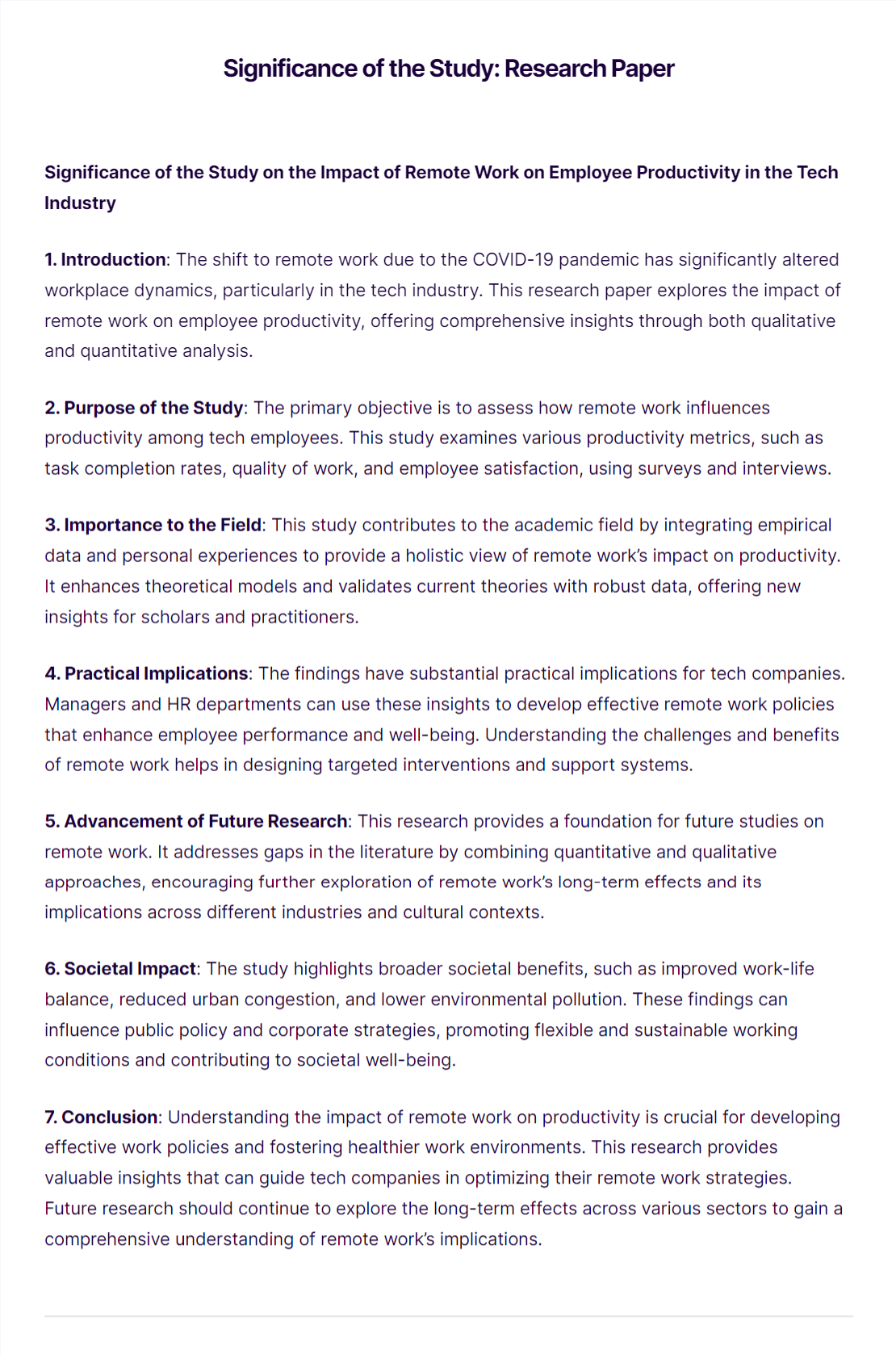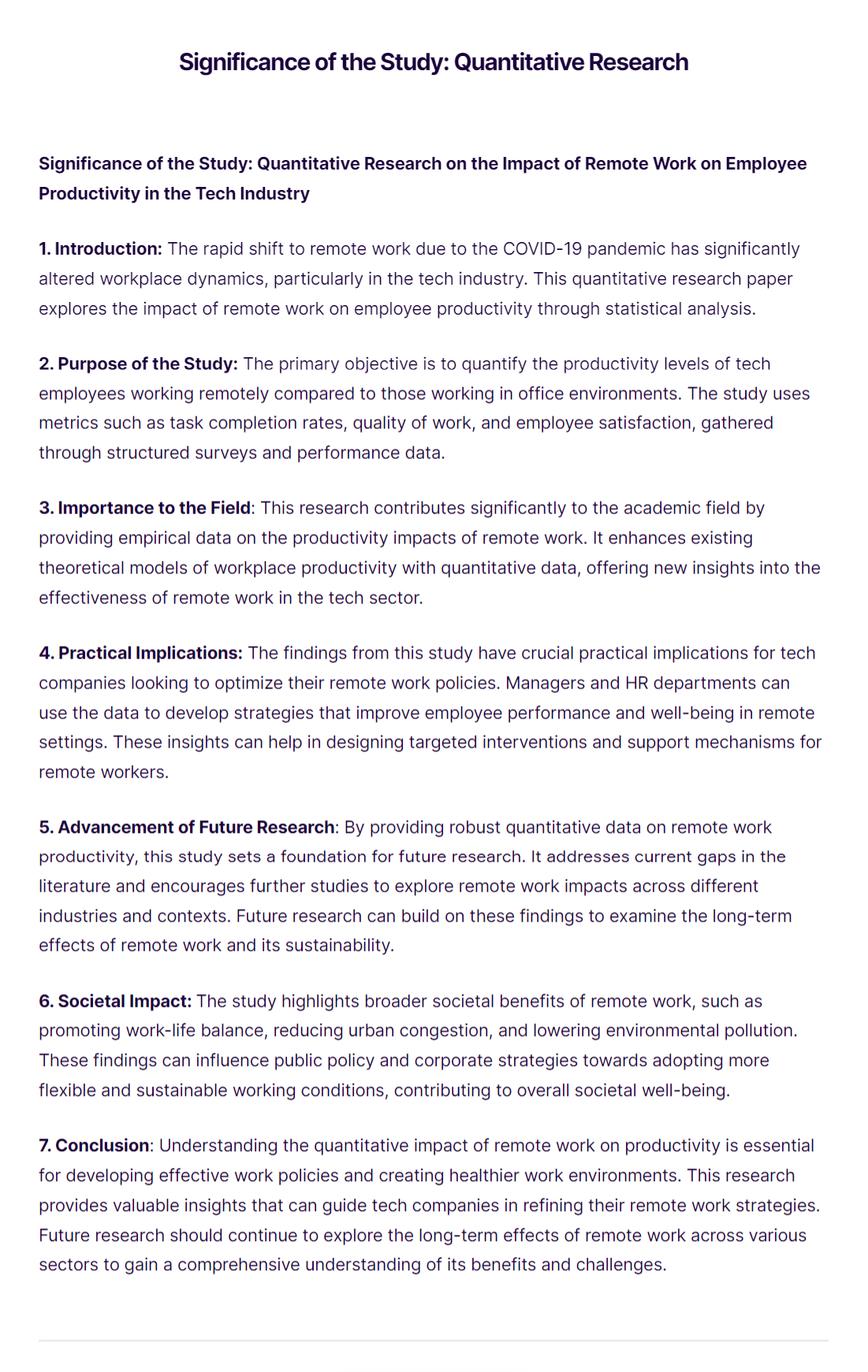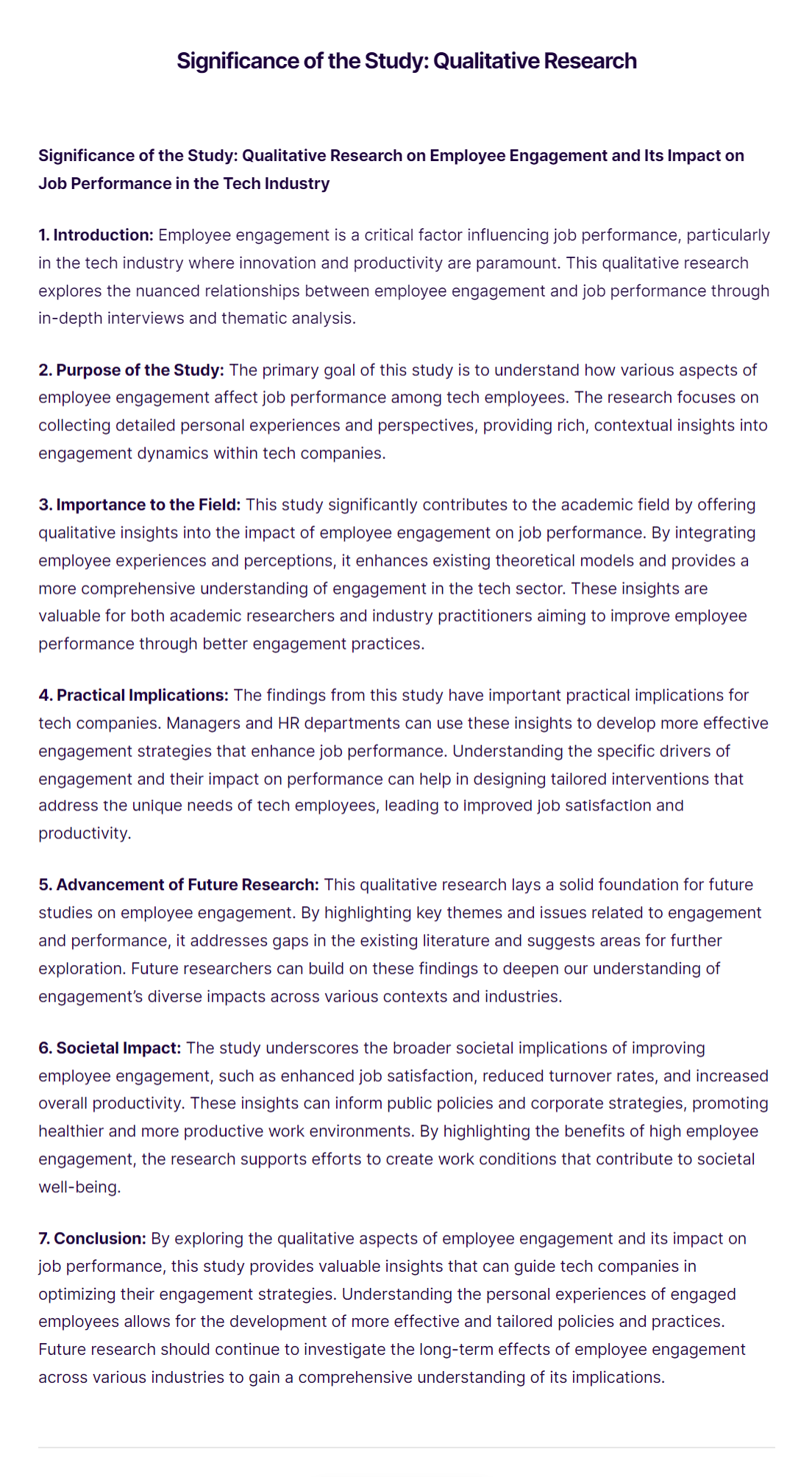

The significance of the study underscores the research’s importance, illustrating its impact on existing knowledge and potential applications. It highlights how the findings address gaps, resolve problems, or contribute to advancements in a specific field. By emphasizing the study’s relevance, it demonstrates the broader implications for society, academia, or industry, justifying the research effort and investment.
The significance of the study illustrates the research’s importance, highlighting its impact on existing knowledge and potential applications. It addresses gaps, resolves problems, or contributes to advancements in a specific field. Emphasizing the study’s relevance, it demonstrates broader implications for society, academia, or industry, justifying the research effort and investment.
When writing the “Significance of the Study” section in a research paper, follow this format to ensure clarity and impact:
The rapid shift to remote work due to the COVID-19 pandemic has fundamentally changed the dynamics of workplace productivity, especially within the tech industry. This study aims to examine how remote work influences employee productivity compared to traditional office settings.
The primary objective of this research is to evaluate the productivity levels of tech employees working remotely versus those working in office environments. The study analyzes various productivity metrics, such as task completion rates, quality of work, and employee satisfaction.
This research contributes significantly to the existing body of knowledge by providing empirical data on the productivity impacts of remote work. It refines theoretical models of workplace productivity and offers new insights into remote work dynamics specific to the tech sector. Understanding these dynamics helps scholars and practitioners alike in shaping effective productivity strategies in the evolving work landscape.
The findings from this study have crucial practical implications for tech companies aiming to optimize their remote work policies. By understanding how remote work affects productivity, managers and HR departments can develop strategies to enhance employee performance and well-being in remote settings. These insights can also assist in designing training programs that equip employees with the skills needed for effective remote work.
This study sets the stage for future research on long-term remote work trends and their impacts across various industries. It addresses existing gaps by providing a detailed analysis of how remote work influences productivity in the tech sector. Future researchers can build on this work to explore remote work dynamics in other fields and under different conditions.
The study highlights the broader societal implications of remote work, such as promoting work-life balance, reducing urban congestion, and lowering environmental pollution. By demonstrating the potential benefits of remote work, this research can influence public policy and corporate strategies towards more sustainable and flexible working conditions, ultimately contributing to societal well-being.
Understanding the impact of remote work on productivity is essential for developing effective work policies and creating healthier work environments. This study provides valuable insights that can guide tech companies in optimizing their remote work strategies. Future research should explore the long-term effects of remote work across different sectors to provide a comprehensive understanding of its benefits and challenges.

Free PDF Download

Free PDF Download

Free PDF Download
When writing academic research or scholarly articles, one critical section is the significance of the study. This part addresses the importance and impact of the research, both theoretically and practically. Here are the main purposes of writing the significance of a study:
The primary purpose is to explain why the study is relevant. It connects the research to existing literature, highlighting gaps or deficiencies that the current study aims to fill. This helps to justify the research problem and demonstrates the necessity of the study.
This section outlines the contributions the study will make to the field. It discusses how the findings can advance knowledge, theory, or practice. The significance emphasizes new insights, innovative approaches, or advancements that the study will provide.
The significance of the study often includes suggestions for future research. By identifying limitations and unexplored areas, it encourages other researchers to pursue related questions. This helps to build a foundation for continuous inquiry and discovery.
Beyond theoretical contributions, the significance of the study highlights practical applications. It shows how the research can solve real-world problems, improve practices, or influence policy-making. This connects academic research to practical outcomes that benefit society.
Writing the significance of a study engages various stakeholders, including scholars, practitioners, policymakers, and funders. It communicates the value of the research to different audiences, making it easier to garner support, funding, or collaboration.
A well-articulated significance section enhances the overall impact of the research. It underscores the importance and potential influence of the study, increasing its visibility and recognition in the academic community and beyond.
Writing the significance of a study offers several benefits that enhance the research’s value and impact. Here are the key benefits:
The significance section clarifies the value of the research by explaining its importance and relevance. It helps readers understand why the study matters and what contributions it aims to make to the field.
This section provides a rationale for the study by highlighting the research problem’s importance. It justifies the need for the study by identifying gaps in existing literature and explaining how the research will address these gaps.
A well-articulated significance section engages and motivates readers, including scholars, practitioners, and policymakers. It draws their interest by showcasing the study’s potential impact and benefits.
Explaining the significance of the study can help secure funding and support from stakeholders. Funding agencies and institutions are more likely to invest in research that demonstrates clear value and potential impact.
The significance section helps guide the research focus by clearly defining the study’s contributions and goals. This clarity ensures that the research stays on track and aligns with its intended purpose.
Demonstrating the significance of a study enhances the researcher’s academic credibility. It shows a deep understanding of the field and the ability to identify and address important research questions.
By identifying gaps and suggesting future research directions, the significance section encourages other researchers to build on the study’s findings. This fosters a continuous cycle of inquiry and discovery in the field.
The significance section highlights practical applications of the research, showing how it can solve real-world problems. This makes the study more appealing to practitioners and policymakers who are interested in practical solutions.
A clear and compelling significance section increases the overall impact of the research. It enhances the study’s visibility and recognition, leading to broader dissemination and application of the findings.
For researchers, writing a strong significance section supports academic and professional goals. It can contribute to career advancement, publication opportunities, and recognition within the academic community.
 How to Write the Significance of a Study" width="1200" height="675" />
How to Write the Significance of a Study" width="1200" height="675" />
Writing the significance of a study involves explaining the importance and impact of your research. This section should clearly articulate why your study matters, how it contributes to the field, and what practical applications it may have. Here’s a step-by-step guide to help you write an effective significance of the study: